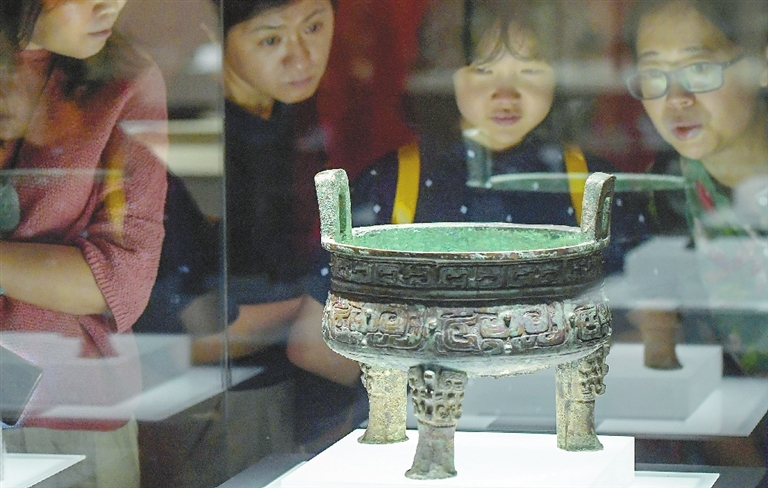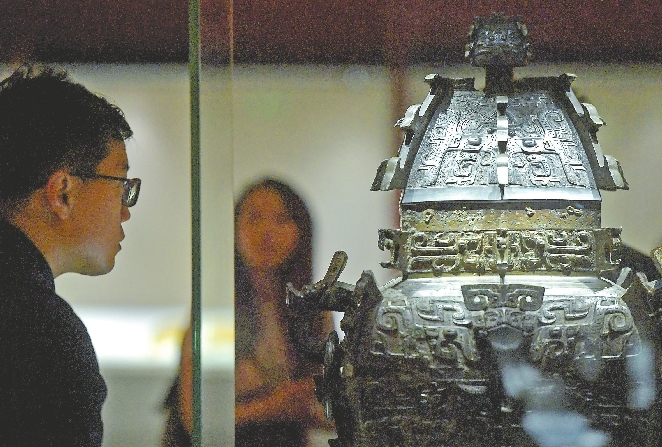

FENG CHEN, a young woman from South China’s Guangxi Zhuang Autonomous Region, was exultant to see Minfanglei, one of the country’s best-known ancient bronze vessels, now on display at the National Museum of China (NMC). “I feel very proud of the work our country has done in repatriation, especially when I found most of the artifacts involved a lot of negotiations and obstacles,” Feng said at the NMC’s exhibition entitled “China’s Achievements in Cultural Relic Retrieval Over the Past 70 Years.” The exquisite designs cast on Minfang-lei, a kind of wine vessel, represent the peak of Chinese bronze culture of the Shang Dynasty (1600-1046 B.C.). The body of the vessel was separated from its lid in the 1920s and sold overseas. Through efforts by Chinese government authorities and collectors, the lost treasure was jointly bought by local enterprises of Central China’s Hunan Province, where the vessel was discovered, and donated to the provincial museum. Over nine decades later, the body of the vessel was finally reunited with its lid in 2014. Its arduous return home has touched many people across China. Divided into four sections, the recently unveiled exhibition runs through late November and illustrates 25 stories of how relics and artifacts were brought home. From the late Qing Dynasty (1644-1911) to the 1940s, China underwent a series of crises when many precious cultural relics were lost overseas. Following the founding of the People’s Republic of China in 1949, a heritage acquisition unit was deployed by then-Premier Zhou Enlai to buy the national treasures back. Items that the unit successfully brought back included “Letter to Boyuan” by celebrated calligraphy sage Wang Xun (349-400), as well as “Five Oxen” by 8th-century artist and prime minister Han Huang, the world’s oldest surviving Chinese paper painting. The unremitting efforts from both the government and non-government organizations have enabled more than 150,000 Chinese cultural relics to return from overseas in around 300 batches since 1949. Repatriations are generally carried out through law enforcement cooperation, lawsuits, negotiations and donations, according to Liu. Since the reform and opening up, China has stopped overseas commercial auctions of lost cultural relics and brought treasures back home more than once. In 1989, China accepted the 1970 UNESCO Convention on the Means of Prohibiting and Preventing the Illicit Import, Export and Transfer of Ownership of Cultural Property and has since entered into bilateral agreements on fighting the illegal transfer and facilitating the repatriation of relics with more than 20 countries. China also released an online platform concerning stolen or lost cultural heritage items in 2017. Each and every relic is an inseparable part of China’s cultural heritage, said Liu Yuzhu, head of the National Cultural Heritage Administration (NCHA), adding that the country’s achievements in cultural relic retrieval symbolize how it has stood up and grown rich and strong over the decades. “Had it not been for China’s own development and its growing prominence in the international arena, none of these treasures would have come home safely,” said Zhou Cailin, who traveled with his colleagues from Hangzhou in East China’s Zhejiang Province to see the exhibition. For historians, relics retrieved from overseas offer hope for solving some of the mysteries of history, said Cao, a postgraduate student majoring in history at Peking University. The exhibition presents China’s splendid civilization, said Nevin Bekis, a judge from the higher court of Germany’s Brandenburg. “These cultural relics belong to the Chinese people and should stay where they came from,” Bekis, a first-time visitor to China, told Xinhua she shares the feelings of Chinese people facing the plundering of cultural relics to overseas. “I am impressed by the dedication of China and the Chinese people to bring them back,” she added. (Xinhua) | 
